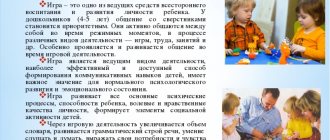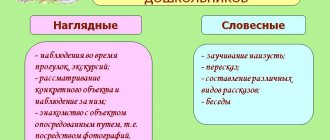Very often, in an impulse, parents cannot stand it and bombard their little child with reproaches and accusations of absent-mindedness and forgetfulness. Remember how often you hear exclamations addressed to a child: “What’s in your head?”, “How can you be so blue?”, “Are you in the clouds again?”
Indeed, almost every day a child has to hear such complaints addressed to him. An adult believes that a preschooler does not know how to direct his attention to the required goal. Therefore, quite often mothers and fathers give their child a “diagnosis” of absent-mindedness.
This situation needs to be sorted out. You can understand the essence of the problem by saying all your complaints to your child, but not out loud. Happened? The answer to the question is very close and after such an experiment it becomes absolutely obvious. The child can concentrate, but his attention is focused on what is important to him, not to the adult.
Why develop attention?
Insufficiently developed attention skills lead to absent-mindedness, forgetfulness and restlessness. Absent-mindedness will seriously harm a child at school - it will be difficult for him to concentrate in class, concentrate on solving problems and find time to prepare homework. This will also affect the future - in “adult” life it will be difficult for a person to make independent decisions and be truly productive.
If you want to avoid such problems, work with your child and do special exercises together that train the skill of voluntary attention.
KINDS
There are several types of attention that have their own specificity in preschool children.
First of all, passive (involuntary, or unintentional) attention, that is, concentration on something interesting, unusual without the child’s volitional efforts. In preschool age, this type is the main one: first, children pay attention to something noticeable, then they begin to be interested in what they did not know before, new to themselves.
The next stage of development is the formation of voluntary attention, and it is important to understand that it will not arise on its own from involuntary attention; for this it is necessary to train the child. The active variety is directly related to volitional efforts, so if a child is sick or irritated, his ability to concentrate decreases. Voluntary attention begins to form at the age of 4-5, although the first type still remains dominant throughout preschool childhood.
Types of attention
Attention can be voluntary or involuntary .
Involuntary attention is inherent in a person from birth. Parents distract a small child by showing him a rattle or grandma's comb; the baby “cries” when he hears music or sees an unusual picture in a book that his mother is reading. Involuntary attention cannot be controlled by consciousness - it arises on its own.
Involuntary attention is formed under the influence of an intense stimulus that evokes an emotional response (loud conversation, bright light bulb, funny children's song, etc.).
For a child's development, training involuntary attention is not enough. In order for any activity, and especially educational activities, to be successful, parents need to focus on the development of voluntary attention.
Voluntary attention arises as a result of a person’s volitional efforts and is controlled by a conscious goal. It is developed as a result of work activity, develops during the formulation and implementation of simple and complex tasks, and is purposeful in nature.
The skill of voluntary attention is necessary for any child. It helps you tune in to solving homework, listen carefully to the teacher, avoid making mistakes, and even set priorities when making a choice in favor of work.
The main function of voluntary attention is the active regulation of mental processes.
Why does a child have reduced attention?
Often children find it difficult to concentrate due to external factors that have a negative impact on their overall development. To avoid such a situation, you need to comply with certain conditions and control almost all aspects of the child’s life. So what should you pay attention to first?
Health
Good health is the main condition for a child to develop fully and comprehensively.
Diseases or illnesses can weaken concentration at any age, but this affects children much more: the baby becomes distracted and apathetic. It is extremely important to find and eliminate the causes of ailments, as well as closely monitor existing pathologies.
Teach your child to lead a healthy lifestyle. Try to limit your time watching TV, playing on the computer and on your smartphone. It is undesirable to overload him with information and affairs. Rest is one of the main components of good health.
Sleeping mode
If a child does not sleep well and does not follow a routine, he becomes chronically absent-minded, which leads to a decrease in school performance, stress and the development of various neuroses. The amount of energy for concentration and memorizing the necessary information also depends on the mode.
Physical activity
If a person’s body is not in good shape, then the brain does not function fully. The level of attention directly depends on the amount of mobility in the child’s lifestyle.
When children are outdoors, running, jumping and playing games, they get out their energy and stimulate active brain function. With enough active recreation or sports in a child’s life, he will be able to perceive and process information faster and better, which will have a positive impact on academic results.
Home furnishings
We are talking about the relationship of parents both with each other and with the child. When there are any problems in the family, discomfort is created and tension increases. Children react to such situations painfully and are the first to be hit emotionally.
As a result, school performance may decline, attention may wander, and the child will not be able to concentrate on the subject and will withdraw into himself. Always maintain a healthy climate in the family, and nothing will distract your child on the way to academic achievements.
How is attention formed in children?
There are several factors that influence the speed of formation of the skill of attention during the learning process. Here are some of them:
- individual pace of learning;
- absence of long pauses in the learning process;
- reliance on active mental activity (application of generalization and comparison tasks, searching for examples and drawing conclusions);
- reliance on existing knowledge and skills;
- accompaniment of intellectual activity with special physical activity;
- absence of external stimuli that attract involuntary attention and distract from the cognitive process (loud remarks, comments, sudden movements, music and conversations);
- clarity and brevity of explanations of adults/conditions of the task that needs to be solved.
Features of the development of younger schoolchildren
When analyzing the development of attention in children of primary school age, it is necessary to take into account that at the age of 7-8 a turning point in life occurs. This is a time of reassessment of values: old motives are replaced by new thoughts and aspirations. It is important to base attention training on the fact that play gradually ceases to be the child’s main activity. Personal development depends on the results of his studies and recognition among peers.
The moment has come when the child thinks before doing something, hides his emotions and experiences, and a loss of childish spontaneity occurs. When developing attention, the emerging sense of responsibility in children of primary school age is involved. Everything that happens around leaves an imprint on his entire future life. The functions of higher nervous activity at this age become voluntary and meaningful.
But external stimuli are still a strong distraction, so it is advisable to perform the following training exercises:
- Forbidden letter or word: the rules are spelled out in advance that you cannot pronounce any letter or word in response to any question.
- Cities and countries, when they name the capitals of countries or continue the names of cities after hearing the last letter of the previous word.
- Training memory and attention - 10-15 objects are laid out on the table in a certain sequence and give the child the opportunity to remember where everything is. After this, you can swap no more than 3 items. Children enjoy finding changes in the arrangement of objects.
- Playing with lines where you need to trace the beginning and end without using a pencil. To enhance interest, an animal is depicted at one end of the line, and a house at the other. The children are intently looking for the animal's way to the house.
- To develop stability, inanimate objects are listed and periodically an animal or flower is among them. At this moment the child should clap his hands. This is a fun game for several kids.
- Finding the difference in pictures is one of the most favorite games among children. From time to time, the images will have to be made more complex, which will increase the effectiveness of learning.
- The task of finishing or coloring the other half of the picture perfectly trains perseverance, attentiveness, and fine motor skills of the hand.
There are a large number of exercises. It is necessary to remember that you need to alternate tasks so that the learning process is always interesting: encourage the desire to learn, teach consistent purposeful actions, strive to bring the work started to its logical conclusion, and always clean up the workplace or play area after yourself.
Training the muscles of the whole body, outdoor games, and morning exercises are also an integral part of mindfulness classes. Mobile “bouncers” with a ball provide an opportunity to have fun, move, and concentrate on several external stimuli.
Exercises to develop attention for preschoolers
In games for attentiveness for preschool children, emphasis should be placed on the formation of voluntary attention. Parents and teachers need to take into account the psychological and age characteristics of the child, consistently introduce him to new material, and rely on existing knowledge and skills.
Exercise No. 1
Place any object in front of the child - it could be a plush toy or some kind of decorative figurine. Ask him to carefully examine the item for a few minutes, then put the item away. The child should close his eyes and describe the object in as much detail as possible. Then return the item to its place and ask the child to name the “missing” details.
Exercise No. 2
Find a picture that shows several pairs of different objects. One item must be without a pair. Show the picture to your child and ask him to find the item. Here is an example with the heroes of Umnasia:
Exercise #3
“Name the color.” Take a piece of paper and write the names of the colors with markers or pencils that do not correspond to them: for example, the word “red” in black, and the word “yellow” in blue. Show your child what you have done and ask him to name the colors in which the words are written. The child should focus on the color of the font, not on the word for the color.
You can diversify the game and add one word, the color of which will correspond to its meaning (for example, write “green” with a green felt-tip pen). Ask your child to find it among the “wrong” words.
Exercise #4
Show your child a picture that shows several different objects divided into groups: for example, five pots of different colors and seven teapots of different shapes and different colors. Ask your child to carefully study the picture and count how many pots and how many teapots he sees. Here is a good example (albeit, instead of kettles and pots there are cats and dogs):
Exercise #5
Show your child two identical images with small and subtle differences. Ask him to find any discrepancies. You can start right now with this picture:
What is attention?
Attention is a mental process that consists of selecting the necessary information in a specific situation and completely rejecting unnecessary information.
The bottom line is that external attention is aimed at objects, personalities, phenomena surrounding a person, in addition to the actions of other people and changes. The child has this feature from the first days of life. The newborn reacts to the voice of his relatives, turns his head towards the source of the noise, and concentrates his attention on his relatives.
The attention of young children, aged from 3 to 6 years, is focused on their experiences and feelings in the inner world. Maximum concentration of the baby's internal attention is achieved at the moment when the child seems to freeze and look intently at some object, but as if not seeing it. At such moments, the child does not react to adults’ reproaches and does not hear speech addressed to him. It is precisely such situations that adults call absent-mindedness.
Exercises for schoolchildren (grades 1-4)
Tasks for schoolchildren improve such characteristics of attention as switchability, distribution and concentration. The child learns to isolate the main thing, “condense” large volumes of educational material into compact diagrams, and control the quality and correctness of the work performed.
Exercise No. 1
Assignment: During a mathematics lesson, teacher Matilda Ilyinichna noticed that Vasya Pchelkin had his head in the clouds and was not listening to the assignment. Approaching his desk, Matilda Ilyinichna saw that Vasya had also drawn stars in his notebook! The teacher at first wanted to give Pchelkin a bad mark, but then she noticed that there was a pattern in the drawings, and even determined how the stars would be located at the place of the gap.
Look at the picture. Can you guess what sequence Vasya followed and which of the listed options he will draw at the place of the pass?
Answer: Let's take a closer look. In the 1st and 2nd rows, remove the top right asterisk from the first picture and get the second picture. We also get the third one. This means that in order to get the third picture in the third row, you need to remove the top two right stars. We get Figure A.
Exercise No. 2
Assignment: Look at the sign and find all the words that are associated with the sea.
Exercise #3
Assignment: This game is called Sudoku. Study the picture carefully. You have four possible heroes. Arrange them in the empty cells of the field so that in each row and in each column not a single hero appears twice.
Exercise #4
Assignment: Koschey Bessmertovich continues to try to destroy humanity. Today he enchanted some words, they were torn into two parts, and now they cannot be used!
All students are busy gluing the pairs back together. Look at the seven half words. Can you help the kids glue them together to make meaningful words? Which half will be left over?
Exercise #5
Look carefully at the picture. Find the missing elements in the block on the right and complete the drawing.
MAGAZINE Preschooler.RF
Development of attention in preschool children with visual impairmentsNapalkova E.N. / teacher-speech pathologist / Khabarovsk MADOOU “Kindergarten of compensatory type No. 156”
Attention is a mental process that is necessarily present when a child learns about the world and is manifested in the direction and concentration of the psyche on certain objects. From the huge flow of information continuously coming from the world around us, thanks to the work of attention, the child chooses the one that is most interesting, significant and important for him. Attention is not an independent mental process; it manifests itself within sensations, perceptions, memory, thinking and other processes as the concentration of consciousness on a reflected object.
Involuntary attention arises as an orienting reaction to the action of visual stimuli that are distinguished by novelty, intensity, contrast, or special significance for the child. It is associated with cognitive activity, interests and needs of the individual.
Voluntary attention is selective sustained activity in relation to any object or event; arises when a certain task is set for the child, both in non-verbal form (demonstration of an action) and with the help of speech. Selective focus of attention ensures special clarity and distinctness of the object. The inclusion of voluntary attention in a particular process significantly changes it, turning it into directed activity.
Post-voluntary attention is a selective activity associated with entry into an activity and with the child’s interest in completing a task that arises in the process.
The qualities of attention are concentration, stability, switching, distribution and volume. Concentration is the degree of concentration on an object or event, which can be high or low. Stability is characterized by the duration of concentration of attention on an object or event. Switching is a conscious transfer of attention from one object or event to another; it can be easy or difficult. Distribution is characterized by maintaining attention on several objects or events at the same time. Volume is the number of objects to which attention is simultaneously directed.
Attention in children with visual impairments develops according to patterns common to children with normal vision. But due to the limited or lack of visual perception, it has its own specific characteristics.
In children with visual impairments, due to a decrease in visual acuity, impairment of binocular vision, visual field, oculomotor and other functions, analyzing perception acquires the features of slowness, fragmentation, multi-stage nature, difficulties arise in the formation of figurative representations and the completeness of perception suffers. Also, with visual impairments in children, a decrease in activity is observed, which is associated with the inability to perceive stimuli with an impaired visual analyzer and respond to them. The lack of visual impressions reduces the level of external stimulation of the child’s activity, which leads to less activity in relation to the outside world. Reducing the number and variety of external impressions has a negative impact on the formation of the quality of attention. The slowness of the perception process affects the rate of switching of attention; incompleteness and fragmentation of images – due to a decrease in volume. The stability of attention in visual impairment decreases with a decrease in the amount of irritation. Rapid fatigue of children with visual impairments in the classroom, slow switching to another type of activity, increasing the time of perception of information, leads to difficulties associated with concentrating on a task, switching from one task to another, distributing attention to individual parts of the task, which leads to absent-mindedness and lack of composure.
Almost all qualities of attention are influenced by impaired vision, but at the same time, attention can develop in children with visual impairments, and reach the same level as in sighted children.
An effective means of developing attention in children with visual impairments are games and exercises that can be used in correctional work (subgroup and individual classes), in joint and independent activities of children.
Games and exercises for developing attention
in preschool children with visual impairments
1. Development of visual attention, image perception, image comparison and analysis skills
"Overlay Images"
The child is presented with contour images superimposed on each other: numbers, geometric shapes, letters, objects. All images must be named.
"Hidden Figure"
The child is presented with contour images of objects, letters, numbers, geometric shapes, which are noisy, i.e. crossed out by lines of various configurations. They need to be identified.
“Color the same shapes with the same color”
Children compare shapes by color and shape, paint identical shapes with the same color.
"Find differences"
Developing the ability to carefully examine, analyze and compare images.
“Find two identical objects”
A card is offered with the image of 5 or more objects, of which two objects are the same, which must be found and shown.
“What’s extra?”
A card is offered with an image of 4-5 objects, one of which is different from the rest. We need to find it.
2. Development of active attention and reaction speed, visual-spatial orientation
"Search non-stop"
Within 10-15 seconds, see around you and name as many objects of the same color as possible.
"Show me quickly"
Search for given objects using pictures (in front of the child there are subject pictures, the teacher names any object, the child must quickly find it).
"Put your finger"
The teacher names any object on the poster or picture, the children find it on the poster (picture) and put their finger on it.
"Sharp Eye"
Find objects in a group based on a given characteristic (color, shape, size, first sound, etc.).
3. Training concentration and stability of attention, switching and distribution of attention, development of perseverance
"Corrector"
The child must find and cross out a letter on sheets of large printed text. Over time, the game can be complicated: for example, cross out the letter A and circle the letter O.
"Cross it out"
The child is offered rows of objects or geometric shapes. Assignment: cross out, for example, mushrooms or circles, and circle a flower or square.
“Arrange the icons as in the example”
“Add rays to the sun, roofs to the houses, leaves to the apple,” etc.
4. Development of visual attention, hand-eye coordination, self-control skills
“Lay out according to the model”
Laying out geometric shapes on a sheet of paper in a given order.
"Mosaic"
Laying out patterns and images according to the sample.
"Repeat the pattern"
Copying the arrangement of figures (by cells, by points, etc.).
Games with counting sticks
Laying out the figures according to the pattern.
"Stringing Beads"
The child is offered a sample or diagram of stringing beads (for example: OXOXOX; OOXXOOXX; OXOXOX, etc.), wire and beads.
"Labyrinths"
The child must find a way out of the maze, first tracing the path with his eyes, then drawing it.
5. Development of visual attention and memory
"What changed?"
Children remember the location of toys (objects, geometric shapes) on the table (on the board, on the shelves of the closet) and turn away. The teacher changes the location of the objects, the children name the changes.
“Tell me what’s behind you (on the closet shelf, next to the board, in the locker room), etc.”
The child must, despite looking at the object, name the objects.
6. Development of auditory attention,
“Clap on a bell, stomp on a rattle” (development of auditory attention)
Children stand with their backs to the teacher and perform a movement to a given sound.
“Clap your hands” (development of auditory attention)
The teacher names a series of words, the children must clap their hands on the given words (for example, the names of trees, modes of transport, items of clothing, dishes, etc.).
"Four forces"
Children perform movements in accordance with the words: earth - hands down, water - hands forward, air - hands up, fire - rotation of the hands in front of you.
"Listen and follow"
When an adult claps his hands, the child must take a certain pose. One clap - stork pose (stand on one leg, tucking the other). Two claps - frog pose (you need to sit down, with your heels together, toes apart, knees apart, hands between your legs on the floor). Three claps - cow pose (get on all fours and say “moo”).
7. Development of motor attention, the ability to obey rules, self-control and self-regulation skills
"It flies - it doesn't fly"
If the teacher names a flying object, the child pretends to be flapping its wings. If the object is non-flying, the child stands calmly.
"Ear - nose".
On the command “ear” children are asked to grab the ear, and on the command “nose” - on the nose.
"Nose, nose, ear"
The teacher quickly says the phrase “nose, nose... and names any part of the body . Everyone has a finger on their nose, the teacher names a part of the body and shows it incorrectly, the children must show this part of the body correctly.
"Prohibited Movement"
The teacher shows the children various movements, which everyone must exactly repeat after him. But one movement is prohibited from repeating! The presenter tries to confuse the players, shows movements at a fast pace, and distracts attention with funny movements. The players’ task is not to make a mistake and not to repeat the prohibited movement after the leader.
Literature:
- Gavrina S. E., Kutyavina N.L., Toporkova I.G., Shcherbinina S.V. “Games and exercises for attention and thinking. Notebook on the development of cognitive processes" . — Academy of Development, 2002
- Grigorieva L.P. "Psychophysiology of attention development in children normally and with complex sensory impairments" . Defectology No. 1, 2002; No. 2, 2003
- Plaksina L.I. Psychological and pedagogical characteristics of children with visual impairment: Textbook. – M.: RAOIKP, 1999
| Next > |








